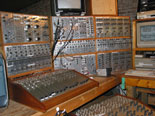Data sheet (Document):
| Folkstreams' practical guides to film digitization and preservation | |
| Complete bibliography Barnes, Heather. "Folkstreams Guide to Best Practices in Film Preservation". In Folkstreams.net [Online] Page accessed on March 27, 2008. | |
| URL http://www.folkstreams.net/ | |
| Type of document Res_enligne |
Participation method Analyse |
| Theme 1- Conservation of media art | |
Observer: Janice Kerfoot |
|
Folkstreams.net provides exposure for American alternative documentary films that have been and continue to be a poor fit to other potential avenues of dissemination due to irregular lengths, subject matter appealing mostly to niche audiences, and/or featured speakers who use dialects and accents markedly unlike the “broadcast English” typical of documentary film narration. The films can be downloaded or streamed free of charge. Each is supported with as many documents, transcriptions, scholarly articles, and other associated texts as are available. The digitized collection parallels a physical preserve of films held at the Southern Folklife Collection at the University of North Carolina in Chapel Hill. The purpose of this datasheet is to draw attention to two resources that exemplify Folkstreams’ creative approach to media archiving, namely “The Folkstreams Guide to Best Practices in Film Digitization” and “Video Aids to Film Preservation”, both funded by the Institute for Museum and Library Services (IMLS). Links to these resources can be found on the front page of Folkstreams.net, which otherwise resembles the interface of a web television station. “The Folkstreams Guide to Best Practices in Film Digitization” (2007) is a concise and comprehensive text prepared by Heather Barnes. Previously published best practice guides for media arts preservation are visited with a critical eye throughout the text in order to explain Folkstreams’ choices. The article begins with comments on Folkstreams’ mandates to set the tone for the practical discussion that follows. The remainder of the text systematically details processes, tasks and challenges involved in film digitization, as the title suggests, but also in the acquisition of materials, dealing with property rights and copyright permissions, creating a website, working with streaming media, generating and entering metadata, and evaluating the usability of the archive’s web interface by seeking user feedback. A reader seeking a case study about (or simply instruction in) digitization will be interested in the overview of Folkstreams’ analog-to-digital “workflow”, which gives a step-by step summary of how tape media (mostly 16mm film and video) is used to create a Digibeta clone to serve as the basis of subsequent emulations, the most important of which being the creation of streaming video files used online. Equally, a reader interested in Folkstreams.net as a case study in information retrieval will appreciate the summary of procedures for indexing, cataloguing, and metadata mapping. A description of the bibliographic record structure used by the database is appended. The second resource, “Video Aids to Film Preservation”, is an expanding series of short video demonstrations available free of charge to stream or download within the rules of Creative Commons. The series was initiated in 2005 and continues to be developed under the direction of Tom Davenport. The video aids are intended to supplement a text-based Film Preservation Guide (also available to download from the web site). Skilled professionals from several different film laboratories have contributed short videos. A typical clip is under a minute long and shows a simple, top-down view of a demonstrator’s hands working through the steps of a task, accompanied by a voice-over verbal explanation of the actions being performed and the equipment and media objects involve. Highly pragmatic concerns are addressed along with the more advanced and technical. Some videos, for example, answer basic questions about recognition and identification (e.g. “How do you identify film by its container, size and shape, and sprocket holes?” and “How are Fuji Single 8 and Kodak Single 8 different?”). Others provide instruction in recognising and treating common problems like mildew and film shrinkage. There is also a group of videos associated with the written guide’s chapter “Equipment for every budget”, that can help demystify the potentially intimidating later stages of film preservation, when specialized tools become necessary. Davenport’s approach demonstrates insight into and respect for the ungoverned, haphazard “life” lead by many audio-visual materials prior to (and leading to) their accession into those collections that represent the media art heritage. Without a doubt, artists’ garages, private curio collections, and poorly equipped libraries of small organizations are the current homes of innumerable films that would be treasures to educators, historians and niche audiences. Rather than lamenting this reality as a failure of elite institutions to secure dominion over “important” media artworks, Folkstreams has provided a resource that encourages and advocates the efforts of non-specialists. Like other forms of media art, films born in certain contexts, in association with established industries and for wide enough audiences, have a program of nurture as their birthright; a program which includes exposure and preservation. Relinquishing control of professional knowledge such that it can be happened-upon by browsing amateurs makes a modest investment in the preservation of media objects born into less privileged scenarios. Professional archivists are not likely to be the first guardians of such works, nor are they likely to be the first to view them as important or interesting. The open documentation of archival practices therefore also makes an implicit endorsement of processes of selection that occur outside conventional art and history institutions. | |
Links: Folkstreams [Online] (Page accessed on March 27, 2008) | |


